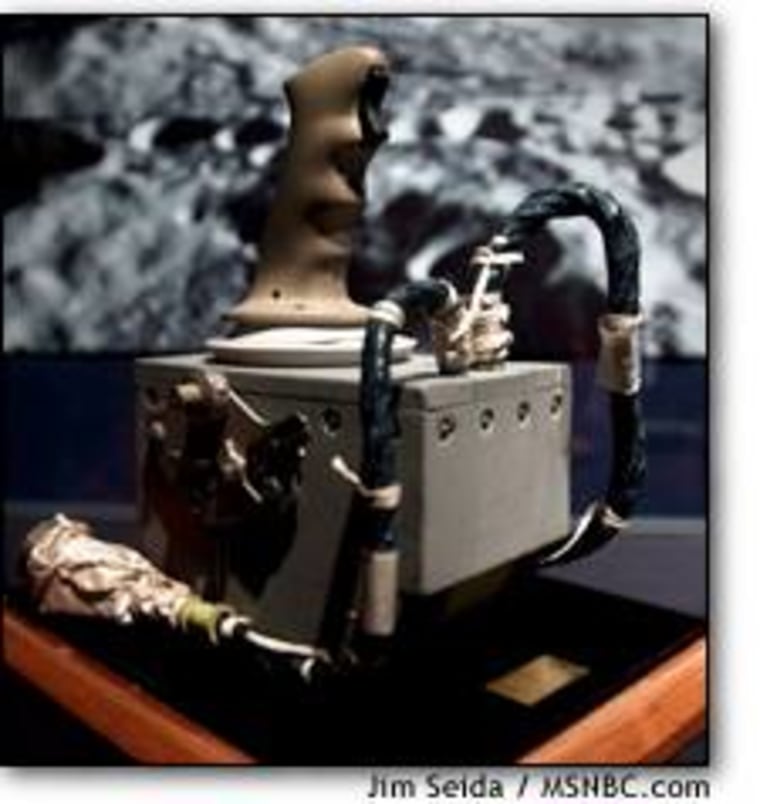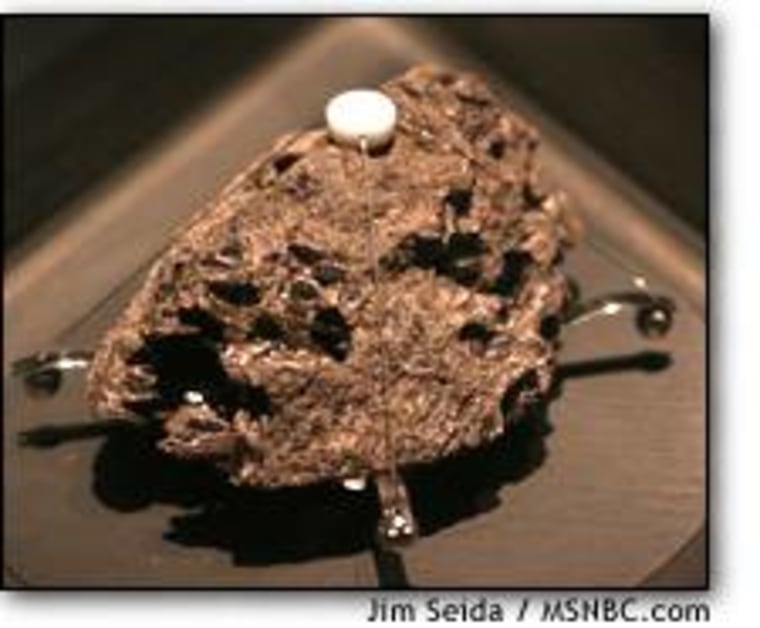“Space: A Journey to Our Future” lets you feel how Galileo felt when he peered through his telescope. You can touch rocks from Mars, and see artifacts from the last mission to the moon. But that mission’s commander, who still ranks as the last man to walk on the moon 31 years later, says the exhibit should be more than a history lesson.
Apollo 17 Commander Eugene Cernan hopes that “Space,” which has its public opening at Seattle’s Pacific Science Center on Saturday, will inspire the next generation to blaze a trail back to the moon and beyond.
“This exhibition is for you,” he told students taking a sneak peak at the 10,000-square-foot exhibit on Thursday. “It’s not just to educate you or to inform you about the past.
To know where we’re going in the future, we have to know where we’ve been. And it’s not so much what we did, but why we did it.”
To be sure, the walk-through displays are heavy on the “what we did,” going back to Stonehenge and prehistoric times. “Space” devotes a lot of space to the earthly study of the heavens: An actor playing the role of Galileo coaxes you to take a look at Jupiter’s moons through his telescope. There are explanations of Newton’s three laws of motion and Einstein’s theory of general relativity, complete with a hands-on doohickey that demonstrates the “rubber-sheet” nature of the space-time continuum. Fictional space travel is noted, too, with tributes to the silent-film classic “Voyage to the Moon” and the radio broadcast of “The War of the Worlds,” among others.
Moon rocks and meteorites
The gee-whiz factor kicks in at full force when you get to the heyday of spaceflight in the 1960s and 1970s: One exhibit re-creates the massive lower section of a Saturn 5 rocket. In another hall, a priceless piece of lunar basalt, brought back to Earth by Apollo 15’s crew in 1971, is on display under glass. You can actually rub your fingers on a lunar meteorite that was found in Oman.

Yet another display case contains the joystick that Cernan used to land Apollo 17’s lunar module, the Hasselblad camera he used and the checklist he wore on the wrist of his spacesuit during his moonwalks. Flecks of moondust, invisible to the naked eye, still coat the checklist’s pages.
Cernan himself was the biggest attraction at Thursday’s preview, fielding questions from journalists as well as the middle school students from Lynnwood, Wash. Jessica Stephens and Brittney Ahn, for example, walked up and asked, “What’s the weather like on the moon?”
“Well, there’s no atmosphere on the moon,” said Cernan, who went on to explain the lack of lunar precipitation and the moon’s wild temperature swings.
The kids also rode a combination exercycle-centrifuge that gave just enough of a spin to induce space dizziness, saw what they’d look like to an infrared eye, and took turns designing their own spaceships and Mars habitats on computerized touchscreens.

In the next room, a spacesuit-clad guide lets you touch a meteorite that was blasted away from Mars millions of years ago. The polished slice was taken from a rock found in Libya, said Dennis Bartz, vice president for exhibit development for Clear Channel Enterprises, which put together the exhibit. Tiny bubbles of gas within the rock matched the composition of the Martian atmosphere, as measured by the Viking probe back in the 1970s.
“They actually contain air from Mars,” Bartz said.
The guide ushers you into a make-believe Mars habitat from the year 2033, where you can guide a rover through a virtual landscape and lie back in a crew bunk. The finale is a big-screen video presentation recapping the past, present and future of space exploration.
The exhibit, presented in collaboration with NASA and sponsored by GM and Lockheed Martin, is due to be on display in Seattle through May 9, then go on to at least a dozen more cities over the next five years.
The 'why' factor
It’s telling that there’s relatively little to see from the space shuttle era, and that may well go to Cernan’s “why” factor. In the aftermath of the Columbia tragedy, space officials, lawmakers and the general public are reconsidering the purpose of spaceflight — an exercise Cernan said was long overdue.

“I tend to be somewhat critical of what we have done over the last 25 or 30 years,” he said. “The fact that I am still the last man to have walked on the moon, 31 years later, says a lot about what we have not done, quite frankly. I don’t believe NASA has had a specific agenda for the last 25 years.”
Some good may well come from the current round of soul-searching, Cernan said. NASA’s current administrator, Sean O’Keefe, was “the right man at the right place at the right time, with vision,” he said.
“I think now we will put an agenda together that says, ‘Here, America, is where were going, here’s what we plan to do, here’s what we can accomplish.’ ... Maybe this exhibit is (among) the first steps, finally, that we’re going to take to Mars. By the time this exhibit tours 10 cities in five years, maybe out there we’ll have a cadre of young dreamers who say that’s where were going to go.”
